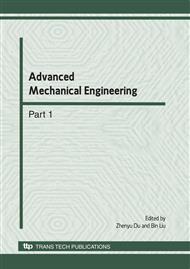p.426
p.430
p.436
p.443
p.448
p.452
p.457
p.462
p.466
Application of Similitude Theory for Welding Deformation Prediction of Large Hydraulic Excavator
Abstract:
A high Computational Complexity of welding deformation Simulation for large hydraulic excavator is visible. Similitude theory is a better way to solve the problem. When neglecting the energy change caused by elastic and plastic deformation, and supposing the geometry similitude of plastic deformation zone, and having the same stress for the plastic deformation zone of the same materials, similar rules of the single-pass welding based on temperature field had been deduced. But we don’t know whether they are effectual for the multi-layer-pass welding. For validating it, a numerical simulation was carried out through simulating the welding process of large hydraulic excavator’s swing arm. And we got the better results. The similar rules deduced on the single-pass welding are also applicable for multi-layer-pass welding under the conditions of the same weld numbers and the same welding sequence.
Info:
Periodical:
Pages:
448-451
Citation:
Online since:
June 2010
Authors:
Price:
Сopyright:
© 2010 Trans Tech Publications Ltd. All Rights Reserved
Share:
Citation:


